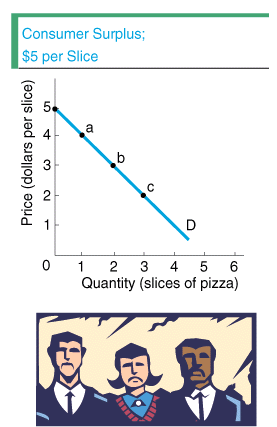Chapter 6
 An important
concept developed in Chapter 6 is consumer surplus.
Consumer surplus reflects the idea that sometimes -
actually, usually - you get more than what you pay
for. More precisely, consumer surplus equals the
difference between the value a consumer places on a
unit of a product and how much the consumer actually
has to pay for the unit. An important
concept developed in Chapter 6 is consumer surplus.
Consumer surplus reflects the idea that sometimes -
actually, usually - you get more than what you pay
for. More precisely, consumer surplus equals the
difference between the value a consumer places on a
unit of a product and how much the consumer actually
has to pay for the unit.
To see how consumer surplus is measured, take
three students, Alfred, Betty, and Charles. Alfred is
really hungry and so is willing to pay $4 for his
first slice of pizza for lunch. Betty is a bit less
hungry; she is willing to pay only $3 for her first
slice of pizza at lunch. Charles is the least hungry
of the bunch, so he is willing to pay only $2 for his
first lunch time slice. All three students are on
diets, so each will buy at most only one slice.
The demand curve in the figure illustrates the
situation outlined above. If the price is $5, no one
buys a slice of pizza and so the quantity demanded is
zero. If the price is $4 per slice, only one slice is
demanded because Alfred buys a slice and this
price/quantity demanded combination is labeled a.
At $3 per slice, two slices are demanded with both
Alfred and Betty buying a slice. This combination is
labeled b. And, at $2 per slice, three slices
are demanded at point c with all three
students buying a slice.
Say that the price of a slice of pizza is $5. As
the figure shows, Alfred, Betty, and Charles are all
unhappy because none of them will buy a slice of
pizza when the price is $5. There is no consumer
surplus because no one is buying a slice of pizza.
Suppose that the price falls to $4 per slice of
pizza. What happens? To find out, click on point a
in the figure.
|